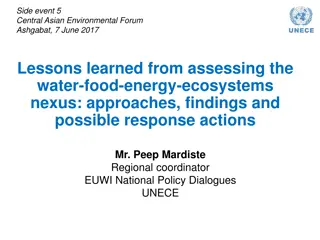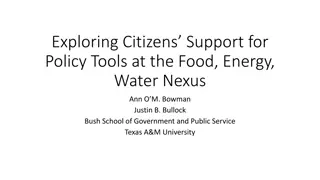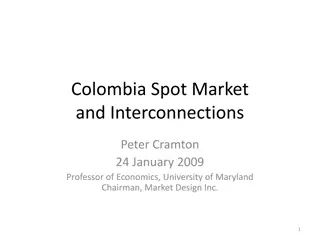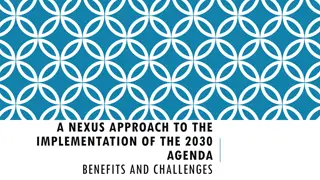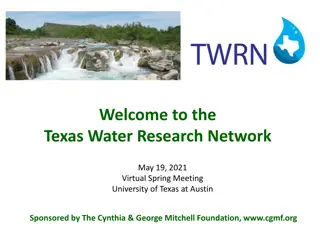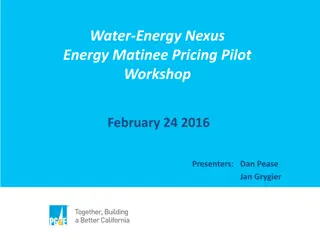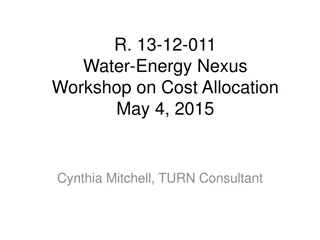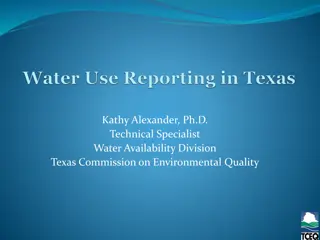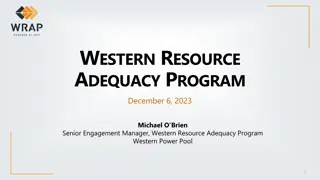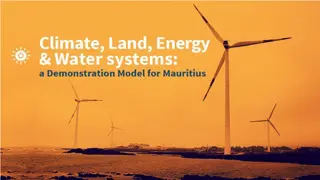Energy-Water Nexus in Texas and Western Interconnections
Explore the intricate relationship between energy production and water resources in the Texas and Western Interconnections at the WSWC/WGA Energy-Water Workshop. Sandia National Laboratories leads the discussion on reducing the water footprint of electricity generation, integrating transmission planning with water management, and evaluating alternative expansion scenarios. The Technical Support Team collaborates with experts from various institutions to develop tools, engage stakeholders, and assess the energy-water nexus. Operational water consumption factors for different electricity generating technologies are also highlighted.
- Energy-Water Nexus
- Texas Interconnection
- Western Interconnection
- Transmission Planning
- Water Management
Download Presentation

Please find below an Image/Link to download the presentation.
The content on the website is provided AS IS for your information and personal use only. It may not be sold, licensed, or shared on other websites without obtaining consent from the author. Download presentation by click this link. If you encounter any issues during the download, it is possible that the publisher has removed the file from their server.
E N D
Presentation Transcript
Photos placed in horizontal position with even amount of white space between photos and header Energy and Water in the Texas and Western Interconnections WSWC/WGA Energy-Water Workshop Denver, CO April 2, 2013 Sandia National Laboratories is a multi-program laboratory managed and operated by Sandia Corporation, a wholly owned subsidiary of Lockheed Martin Corporation, for the U.S. Department of Energy s National Nuclear Security Administration under contract DE-AC04-94AL85000.
Technical Support Team Sandia National Laboratories Vincent Tidwell Barbie Moreland Howard Passell Katie Zemlick Barry Roberts Argonne National Laboratory John Gasper Eugene Yan Chris Harto Electric Power Research Institute Robert Goldstein National Renewable Energy Laboratory Jordan Macknick Kathleen Hallett Idaho National Laboratory Gerald Sehlke Dan Jensen Chris Forsgren Pacific Northwest National Laboratory Mark Wigmosta Ruby Leung University of Texas Michael Webber Carey King
Integrated Planning Transmission Planning Water Management Energy Security
Energy and Water in the Western and Texas Interconnections Reduce the water footprint of electric power production in western United States: o Develop tools for a quantitative assessment of the energy-water nexus, o Engage stakeholders across the energy-water spectrum, and o Evaluate water implications of alternative interconnection-wide transmission expansion scenarios.
Transmission Planning WECC and ERCOT are conducting long-range transmission planning (20 yrs.) o Siting of new power plants o New transmission capacity
Operational water consumption factors for electricity generating technologies Caption or heading (if you have one) Recirculating Cooling Hybrid Cooling No Cooling Required Dry Cooling Once-through Cooling Pond Cooling Operational water consumption (Gal/MWh) (insert really cool image/supergraphic from your work) CSP and PV Biopower Nuclear Natural Gas Coal Source: Macknick et al. 2011
CLIMATE VARIABILITY IMPACTS ON ELECTRICITY GENERATION Evaluate impacts of future (2030s) climate variability, drought scenarios, and water demand Potential reduction or curtailment of power generation Low lake levels Thermal effluent limitations
Hydrologic Modeling Results Single-Year Drought Projected Reservoir Capacity in HUC-8 Basins
Hydrologic Modeling Results Multiple- Year Drought Projected reservoir storage in HUC-8 basins under 1950-1957 drought scenario 1954 1956 1955
Operations near thermal limit 115 500,000 Average Monthly Effluent Temperature (deg. 450,000 110 Electricity generation (MWh) 400,000 105 350,000 100 300,000 95 250,000 90 200,000 F) 85 150,000 80 100,000 75 50,000 70 0 Aug-06 Feb-07 Aug-07 Avg. Effluent Temperature (deg. F): EPA Predicted Avg. Effluent Temperature (deg. F), +/- 2 SD error bars Avg. Temp. Limit Generation (MWh) Feb-08 Aug-08 Feb-09 Aug-09 Feb-10 Aug-10 Feb-11 Aug-11
Operations near thermal limit in future summers Assuming 2011 generation pattern 115.0 110.0 105.0 Outlet Temperature (F) 100.0 95.0 90.0 85.0 80.0 75.0 70.0 Dec-25 Apr-27 Sep-28 Jan-30 Jun-31 Oct-32 Feb-34 Time (Month- Year) Outlet temperature (avg. deg. F) Outlet temperature (avg. deg. F) 100% Capacity in Summer EPA Permit level (max avg. Temperature, deg. F)
Power Plant Siting Decisions West-wide objectives Minimize cost Maximize reliability Maximize transmission capacity utilization Limit exposure to policy change Minimize stress over water Power plant siting criteria Fuel type Cooling type Capacity Location Water source
Key Water Sources Potable Water Unappropriated surface water Unappropriated groundwater Appropriated water (rights transfers) Relative Availability and Cost Non-Potable Water Municipal/Industrial wastewater Shallow brackish water
Water Availability Indicators: Demand Focus on withdrawals Estimate consumption from withdrawals Disaggregate by: o 8-digit watershed o Sector M&I Agriculture Evaporative Instream o Water source
Water Availability Indicators: Supply Interbasin Transfers Mean Gauged Streamflow Annual Low Flow Reservoir Storage Groundwater Depletion
Water Availability Indicators: Institutional Factors Unappropriated Water Adjudication Status Indian Water Administrative Control Areas
Metric Development Data on available water are rare As such, metrics were estimated from available information Assisted by volunteer team from WSWC Bret Bruce (USGS) Dan Hardin (TX) Sara Larsen (WSWC) Dave Mitamura (TX) Andy Moore (CO) Ken Stahr (OR) Todd Stonely (UT) Steve Wolff (WY) Dwane Young (WSWC)
Energy for Water Calculator Update Energy for Water Model Energy for Large Projects Energy for Agriculture
Water Use Data Exchange (WaDE) Use Web Services to transfer data Data Stay at the Source (i.e. the states) Provide transparent link between state data and integrated water metrics Link to metadata Changes in state data are automatically reflected in metrics
Vincent Tidwell vctidwe@sandia.gov (505)844-6025 http://energy.sandia.gov/


